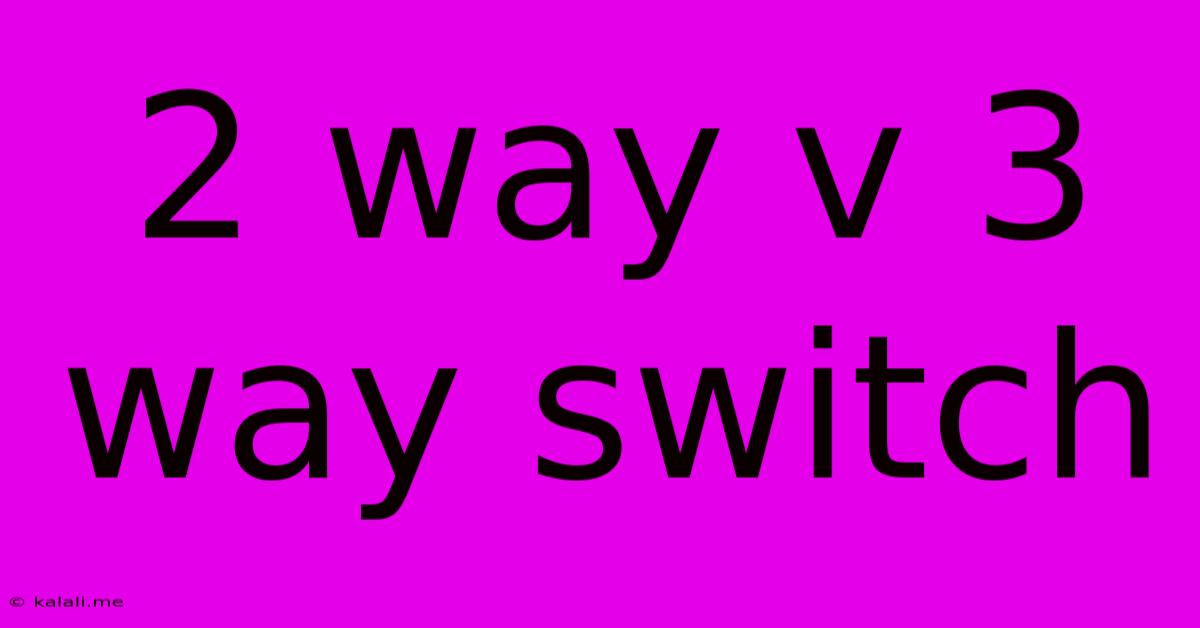2 Way V 3 Way Switch
Kalali
Jun 04, 2025 · 4 min read

Table of Contents
2-Way vs. 3-Way Switches: Understanding the Differences and Applications
This article delves into the differences between 2-way and 3-way switches, explaining their functionalities, wiring diagrams, and ideal applications. Choosing the right switch is crucial for efficient and safe electrical systems in your home. Whether you're a seasoned DIYer or a homeowner tackling a simple wiring project, understanding these differences is essential.
What is a Light Switch? A light switch is a simple on/off device that controls the flow of electricity to a light fixture or other electrical appliance. However, the complexity increases when you need to control a light from multiple locations. This is where 2-way and 3-way switches come into play.
Understanding 2-Way Switches
A 2-way switch, also known as a single-pole switch, offers a simple on/off control from a single location. It's the most common type of switch found in homes and is straightforward to install and operate. Think of it as a simple toggle – it's either on or off. This switch only has two terminals for connecting wires: one for the power supply (incoming "hot" wire) and one for the light fixture (outgoing "hot" wire). The neutral wire is connected directly to the light fixture.
Ideal Applications: Perfect for controlling lights from a single point.
Wiring Diagram: A simple diagram shows the incoming hot wire connected to one terminal, the outgoing hot wire to the other, and the neutral wire directly connected to the light fixture.
Understanding 3-Way Switches
A 3-way switch allows you to control a light or appliance from two different locations. This is incredibly useful for hallways, staircases, or bedrooms where a light switch at either end would be convenient. Unlike a 2-way switch, a 3-way switch has three terminals – two for connecting the hot wires from other switches and one for connecting the hot wire to the light fixture. This requires a specific wiring configuration that involves using two 3-way switches and a common neutral wire.
Ideal Applications: Perfect for controlling lights from two different locations. Common use cases include stairwells, hallways, and bedrooms with entry points from multiple rooms. They are often used in conjunction with dimmer switches, further enhancing the control and functionality of the lighting system.
Wiring Diagram: Requires a more complex diagram showcasing the interconnection between the two 3-way switches and the light fixture. The hot wire is connected through both switches before reaching the light. The neutral wire still connects directly to the fixture.
Key Differences Summarized:
| Feature | 2-Way Switch | 3-Way Switch |
|---|---|---|
| Control Locations | One | Two |
| Terminals | Two | Three |
| Wiring Complexity | Simple | More complex |
| Common Use Cases | Single point light control | Multiple point light control |
Choosing the Right Switch: 2-Way or 3-Way?
The choice between a 2-way and a 3-way switch depends entirely on your needs. If you only need to control a light from one location, a 2-way switch is sufficient. If you need control from two different locations, you will absolutely require a pair of 3-way switches, with appropriate wiring. Improperly wiring these switches can result in electrical malfunctions or safety hazards. If you're unsure, it’s always best to consult with a qualified electrician. They can assess your electrical setup and recommend the appropriate switch configuration.
Advanced Considerations: 4-Way Switches and Smart Home Integration
While less common than 2-way and 3-way switches, 4-way switches allow control from three or more locations. These are used in more complex wiring configurations and often in conjunction with 3-way switches.
Modern smart home technology also integrates seamlessly with both 2-way and 3-way switches, allowing for remote control and automation via smartphone apps or voice assistants. These smart switches add significant convenience and functionality to your lighting system.
By understanding the differences between 2-way and 3-way switches, you can make informed decisions about your home's electrical system, ensuring both functionality and safety. Remember that proper wiring is crucial, and seeking professional help if needed is always the safest option.
Latest Posts
Latest Posts
-
Does Biology View The Body As A Machine
Jun 06, 2025
-
How To Get Rid Of Grass Clippings
Jun 06, 2025
-
How Do You Change Default Pi User
Jun 06, 2025
-
Do You Have To Change Rotors When Replacing Brake Pads
Jun 06, 2025
-
Can You Use A Schrader Tube On A Presta Rim
Jun 06, 2025
Related Post
Thank you for visiting our website which covers about 2 Way V 3 Way Switch . We hope the information provided has been useful to you. Feel free to contact us if you have any questions or need further assistance. See you next time and don't miss to bookmark.